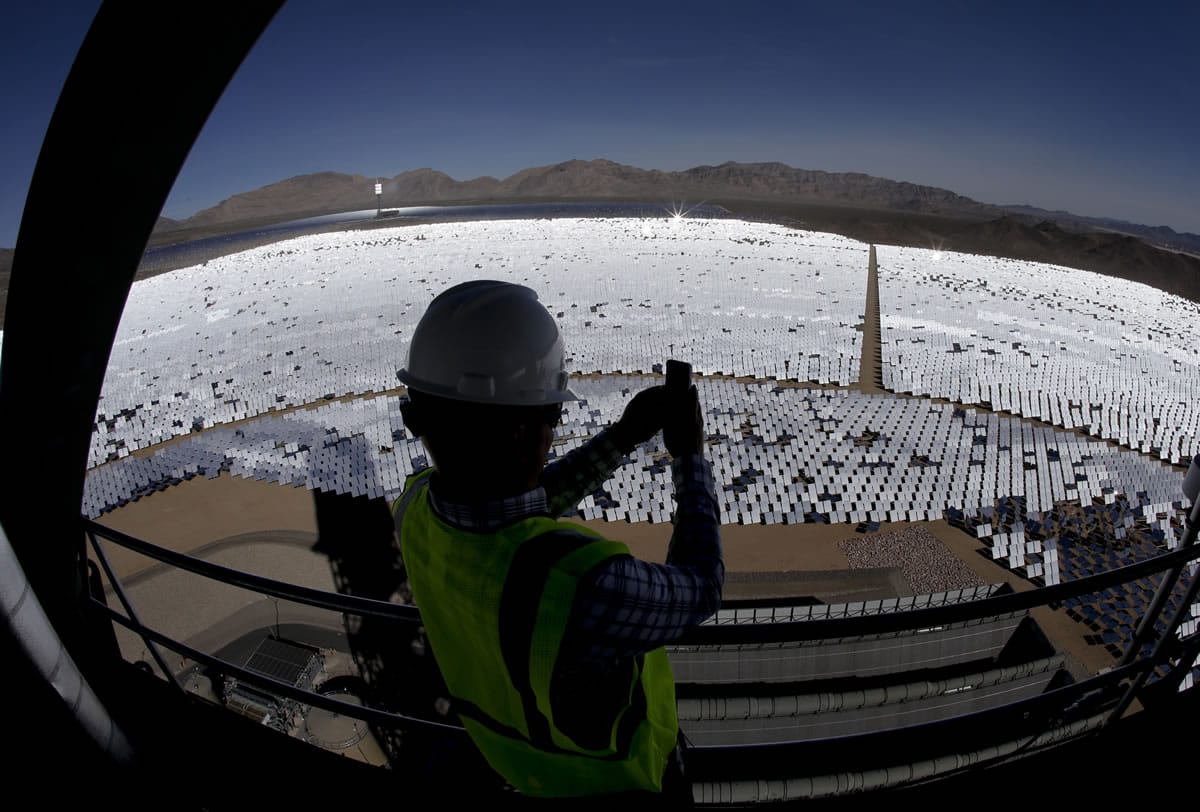PRIMM, Nevada — A windy stretch of the Mojave Desert once roamed by tortoises and coyotes has been transformed by hundreds of thousands of mirrors into the largest solar power plant of its type in the world, a milestone for a growing industry that is testing the balance between wilderness conservation and the pursuit of green energy across the American West.
The Ivanpah Solar Electric Generating System, sprawling across roughly 5 square miles of federal land near the California-Nevada border, formally opened Thursday after years of regulatory and legal tangles ranging from relocating protected tortoises to assessing the impact on Mojave milkweed and other plants.
“The Ivanpah project is a shining example of how America is becoming a world leader in solar energy,” U.S. Energy Secretary Ernest Moniz said in a statement after attending a dedication ceremony at the site. “This project shows that building a clean-energy economy creates jobs, curbs greenhouse gas emissions and fosters American innovation.”
The $2.2 billion complex of three generating units, owned by NRG Energy Inc., Google Inc. and BrightSource Energy, can produce nearly 400 megawatts — enough power for 140,000 homes. It began making electricity last year.
Larger projects are on the way, but for now, Ivanpah is being described as a marker for the United States’ emerging solar industry. While solar power accounts for less than 1 percent of the nation’s power output, thousands of projects from large, utility-scale plants to small production sites are under construction or being planned, particularly across the sun-drenched Southwest.
The opening of Ivanpah is “a dawn of a new era in power generation in the United States,” said Rhone Resch, president of the Solar Energy Industries Association, a trade group.
The plant’s dedication comes as government continues to push for development of greener, cleaner power.
President Barack Obama has mounted a second-term drive to combat climate change, proposing first-ever limits on carbon pollution from new and existing power plants. His plan aims to help move the U.S. from a coal-dependent past into a future fired by wind and solar power, nuclear energy and natural gas.
According to U.S. Energy Information Administration data, the cost of building and operating a new solar thermal power plant over its lifetime is greater than generating natural gas, coal or nuclear power. It costs a conventional coal plant $100, on average, to produce a megawatt-hour of power, but that figure is $261 for solar thermal power, according to 2011 estimates. The figures do not account for incentives such as state or federal tax credits that can affect the cost.
Ken Johnson, a spokesman for the solar association, said in a statement that solar systems have seen “dramatic price declines” in the last few years.
That’s good for utilities in California, which must obtain a third of their electricity from solar and other renewable sources by 2020.
Lots of sunshine
The Ivanpah site, about 45 miles southwest of Las Vegas, has virtually unbroken sunshine most of the year and is near transmission lines that carry power to consumers.
Using technology known as solar-thermal, nearly 350,000 computer-controlled mirrors roughly the size of a garage door reflect sunlight to boilers atop 459-foot towers. The sun’s power is used to heat water in the boilers’ tubes and make steam, which drives turbines to create electricity.
While many people are familiar with rooftop solar, or photovoltaic panels, “these are a little bit different. This takes the sun’s rays and reflects them onto towers,” said NRG spokesman Jeff Holland.
The plant can be a startling sight for drivers heading toward Las Vegas along busy Interstate 15. Amid miles of rock and scrub, its vast array of mirrors creates the image of an ethereal lake shimmering atop the desert floor. In fact, it’s built on a dry lakebed.
Google announced in 2011 that it would invest $168 million in the project. As part of its financing, BrightSource also lined up $1.6 billion in loans guaranteed by the U.S. Energy Department.
Ivanpah can be seen as a success story and a cautionary tale, highlighting the inevitable trade-offs between the need for cleaner power and the loss of fragile, open land. The California Energy Commission concluded that while the solar plant would impose “significant impacts on the environment … the benefits the project would provide override those impacts.”
Such disputes are likely to continue for years as more companies seek to develop solar, wind and geothermal plants on land treasured by environmentalists who also support the growth of renewable energy. At issue is what is worth preserving and at what cost, as California pushes to generate more electricity from renewable sources.



